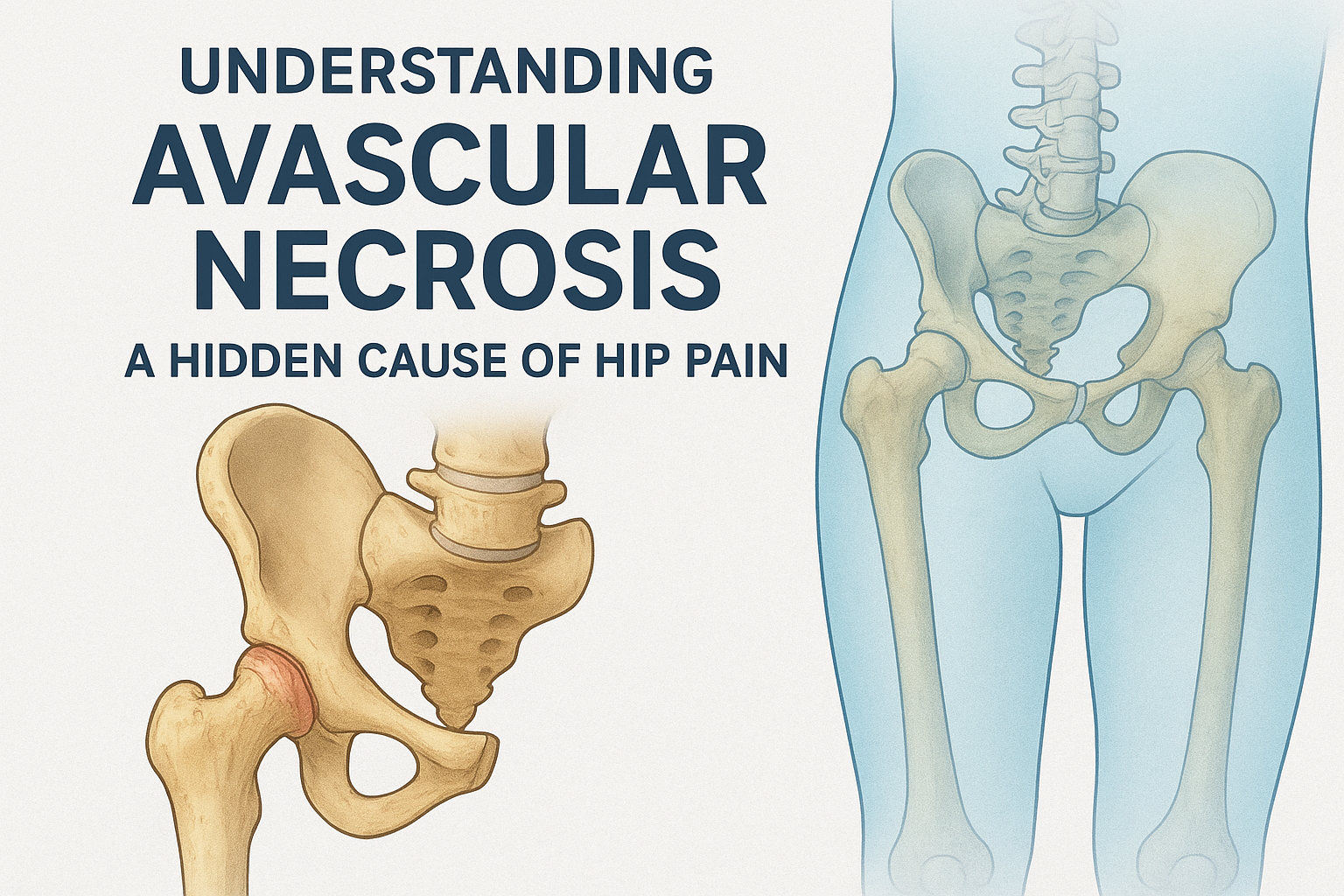Hip pain is often linked to arthritis, injury, or simple wear and tear with age. But in some cases, the pain may stem from a lesser-known yet serious condition called Avascular Necrosis (AVN), also known as osteonecrosis. AVN is a progressive condition that can cause severe joint damage if not diagnosed and treated early.
What is Avascular Necrosis?
Avascular necrosis occurs when blood supply to the bone is reduced or completely cut off. Without adequate blood flow, bone tissue begins to die, leading to tiny cracks and eventual collapse of the bone structure. The hip joint is most commonly affected, but AVN can also occur in the knees, shoulders, and ankles.
Common Causes of Avascular Necrosis (AVN)
Avascular necrosis (AVN), also called osteonecrosis, is a painful and progressive condition caused by reduced blood supply to the bone. Without proper circulation, the bone tissue starts to die, leading to weakening, collapse, and ultimately joint damage. While the hip joint is the most commonly affected, AVN can also occur in the knee, shoulder, or ankle. Understanding the common causes of AVN is key to early detection, prevention, and timely treatment.
1. Trauma or Injury
One of the leading causes of AVN is direct injury to a bone or joint. A hip fracture, dislocation, or severe accident can damage the blood vessels that supply oxygen and nutrients to the bone. When these vessels are blocked or torn, circulation is interrupted, increasing the risk of AVN.
2. Prolonged Steroid Use
Long-term or high-dose use of corticosteroids, commonly prescribed for conditions such as asthma, arthritis, or autoimmune diseases, is another major risk factor. Steroids can affect the body’s ability to break down fat properly, causing fat deposits that block blood flow to the bone.
3. Excessive Alcohol Consumption
Heavy drinking over time is strongly linked to AVN. Alcohol interferes with fat metabolism, leading to fatty deposits in the blood vessels. These deposits can obstruct circulation, depriving the bone of nutrients and oxygen.
4. Blood Disorders
Conditions like sickle cell anemia, clotting disorders, and leukemia can reduce blood flow or cause blockages in small blood vessels. Over time, these issues may limit circulation to bones, particularly in the hips, triggering AVN.
5. Radiation Therapy and Chemotherapy
Cancer treatments, especially radiation therapy, may weaken bones and damage blood vessels, raising the risk of AVN. Chemotherapy can also contribute by affecting bone health and blood circulation.
6. Autoimmune Diseases
Diseases such as lupus and rheumatoid arthritis often require long-term steroid treatment, but they can also independently affect circulation and bone health, compounding the risk of AVN.
7. Decompression Sickness
Also known as “the bends,” this condition occurs in divers and pilots when nitrogen bubbles form in the bloodstream due to rapid pressure changes. These bubbles can obstruct blood vessels and lead to AVN.
Symptoms to Avascular Necrosis (AVN)
In the early stages, AVN may not cause noticeable symptoms. As the condition progresses, common signs include:
Persistent or worsening hip pain, especially with movement.
Pain that radiates to the thigh, buttock, or groin.
Stiffness and reduced range of motion in the hip.
Difficulty walking or standing for long periods.
How is AVN Diagnosed?
Doctors use a combination of physical examination and imaging tests to diagnose AVN. X-rays may reveal bone changes in later stages, but MRI scans are the most effective for detecting AVN in its early phases.
Treatment Options for Avascular Necrosis (AVN)
Avascular necrosis (AVN), or osteonecrosis, occurs when reduced blood supply causes bone tissue to die. Left untreated, it can lead to bone collapse, severe pain, and joint damage—most commonly in the hip. The good news is that with early detection and proper treatment, AVN progression can be slowed or even stopped. Treatment depends on the stage of the condition, severity of symptoms, and overall health of the patient.
1. Medications
In the early stages, medications may help relieve pain and slow progression:
Nonsteroidal anti-inflammatory drugs (NSAIDs): Reduce pain and inflammation.
Blood thinners (anticoagulants): Prevent blood clots that may worsen AVN.
Cholesterol-lowering drugs: Reduce fat in the blood that can block circulation.
Bone-strengthening drugs (bisphosphonates): Support bone density and delay collapse.
2. Lifestyle Modifications
Rest and limited weight-bearing: Reducing stress on the affected joint with crutches or a cane can help slow bone damage.
Exercise and physiotherapy: Gentle range-of-motion exercises maintain joint flexibility.
Alcohol and steroid management: Avoiding excessive alcohol and discussing alternatives to long-term steroid use can reduce progression.
3. Medical Procedures
Core decompression: A surgical procedure where part of the inner bone is removed to relieve pressure, improve blood flow, and encourage healing.
Bone grafting: Healthy bone tissue, sometimes combined with stem cells, is transplanted to repair the damaged area.
Electrical stimulation: Promotes bone growth and healing by stimulating new blood vessels.
4. Advanced Surgical Options
If AVN has progressed to bone collapse or arthritis:
Osteotomy: Reshaping the bone to reduce stress on the damaged area.
Total joint replacement (arthroplasty): Damaged bone and cartilage are replaced with an artificial joint, most commonly in severe hip AVN.
Vascularized bone graft: Using healthy bone with its own blood supply to restore circulation in the affected area.
5. Regenerative Medicine Approaches
Cutting-edge treatments like stem cell therapy are showing promising results in early stages of AVN, as they help regenerate bone tissue and improve blood flow.
Conclusion
Avascular necrosis is a hidden but serious cause of hip pain that can drastically impact mobility if ignored. Early detection and timely treatment are crucial to preserving joint function and preventing complications. If you experience persistent hip pain that doesn’t improve with rest, consulting an orthopedic specialist can make all the difference.
With his expertise in orthopedics, Dr. Abhisekh Orthocare provides advanced evaluation, modern treatment options, and individualized care to help patients manage AVN effectively. His commitment ensures not just pain relief but also the restoration of mobility and quality of life.

